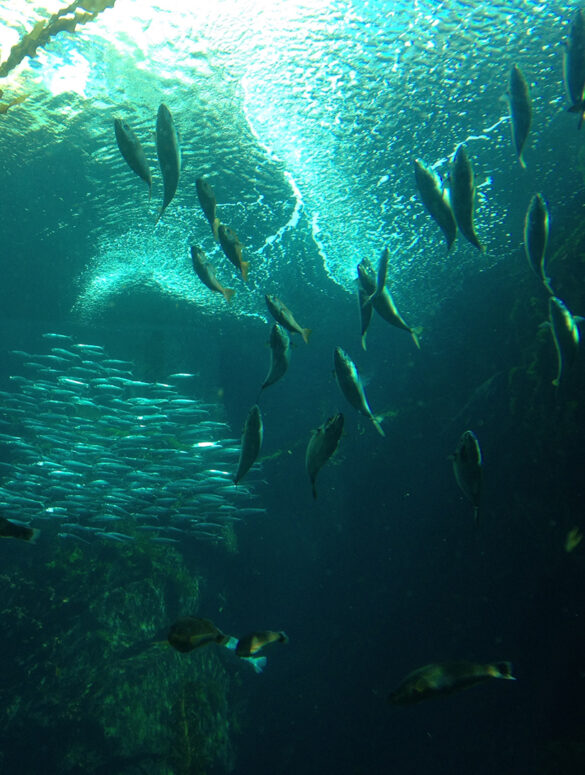Text by Christine Hitt
Images by Tom Boyd and courtesy of The Bay Foundation
The difference is like night and day. What was once a barren underwater landscape of reef overrun by millions of urchins is now a kelp forest teeming with life. Anchored to the sea floor, long stalks of kelp tower in the water, their giant fronds bouncing with the current. Schools of fish flit through the greenery.
Kelp forests provide habitat and food for more than 700 species, but 80 percent of the kelp forests in Santa Monica Bay have been lost in the past 100 years. Only a few centuries ago, Indigenous people thrived alongside the bay, which had a rich and balanced life.
A hundred whales could be seen for every one spotted today; 100,000 sea otters roamed the coastline; and kelp forests, crab, abalone, and fish were abundant Tuna even created a major industry for Los Angeles in the first half of the 20th century that is depicted on the County of Los Angeles’ seal.
But now, that’s the stuff of nostalgia.
-

Image by Tom Boyd -

Image by Tom Boyd
The growing return of kelp to the area is a success story for The Bay Foundation, a nonprofit environmental group focused on Santa Monica Bay, which has restored about 52 acres of kelp forest off the Palos Verdes Peninsula since 2013.
“When urchins don’t have predators, they become overly numerous, dominating reefs, eating the entire kelp forest that was there, and then prevent the kelp forest from ever growing back again, on a scale of decades if not centuries,” says Tom Ford, the executive director for The Bay Foundation since 2014.
He’s been working in kelp restoration for more than 20 years.
“Two of the biggest things that we can point to was the loss of the sea otters because they were hunted out to extinction locally. And post-World War II, the effluent from our sewage treatment plant was very concentrated, untreated, and there was a lot of it.”
The removal of the otters, which were one of the main predators of the urchins, directly changed the ecology and allowed the purple urchin population to swell.
Ford began restoring kelp forests off Malibu in 2002 and Palos Verdes in 2005, where an excessive number of urchins have eaten the kelp forests bare, with the Santa Monica Baykeeper (now the Los Angeles Waterkeeper).
In 2010, he launched a project at The Bay Foundation that showed how reducing urchin densities would bring kelp back. The foundation also found that 75 percent of the kelp canopy had been lost off Palos Verdes, and mapped the 150 acres of urchin barrens it is now focused on restoring.
“When urchins don’t have predators, they become overly numerous, dominating reefs, eating the entire kelp forest that was there, and then prevent the kelp forest from ever growing back again, on a scale of decades if not centuries.”
Tom Ford, The Bay Foundation
In 2013, the largest restoration effort to date started when The Bay Foundation began clearing urchins in the waters off Palos Verdes. The work has included more than 10,000 hours of scuba diving to map and monitor the areas and cull urchins.
Overall, 4 million urchins have been culled in 52 acres with the help of five commercial fishermen. The partnership is mutually beneficial because the urchins in the barrens have no value to the fishermen, compared to urchins living in healthy environments. These urchins are starving.
“It was really one of the rare times that environmentalists and fishermen were working together for a common cause,” says Heather Burdick, director of marine operations for The Bay Foundation.
When the urchins are cleared, the kelp grows back very quickly—from a microscopic size to two meters tall in a couple months.
Once it reaches 30 feet, it can grow two feet per day. With the kelp forests restored, underwater footage has already captured sea life returning to a sustainable, healthy environment. A sea lion hangs around the kelp, and mollusks and crustaceans skitter across the sea floor.
Burdick is also part of The Bay Foundation’s abalone restoration program, which works with a captive breeding program to repopulate abalone on the reef where the kelp forest is restored.
-

Image by Tom Boyd -

Image by Tom Boyd
“Urchins are very active feeders, so if they become overabundant, they will attack the kelp forest. … Abalone do not do that,” Burdick says. “They stay in crevices and they just wait for algae to drift by. And because they’re taking up space on the reef, it’s less area that urchins could settle and potentially create a barren. So by having abalone on the reef, you’re sort of setting up a better balance of what organisms should be living there.”
A healthy kelp forest does more than affect marine life. “The decline of our fisheries and the tuna being gone, all these things are largely related to us over-harvesting our local environment,” Ford says. “By restoring the kelp forests, we can put those jobs back and we can put those lives back.”
-

Image courtesy of The Bay Foundation
Kelp also protects the coastline from erosion and helps mitigate climate change by taking carbon out of the ocean, which then pulls it out of the atmosphere. Kelp forests sequester carbon incredibly efficiently thanks to their quick growth and typical final resting place on the deep-sea floor.
The marine algae also affects water quality by pulling nutrients out of the water for its own growth that otherwise could result in harmful algal blooms. This benefits fisheries, public health, and coastal tourism.
“When the kelp is washing up on the beach and on the rocks along the coastline, it helps build sand dunes,” Ford adds. “It helps nourish plants that, if we were ever to allow them to grow on the beach, could get taller and protect against sea level rise. They connect all of that marine life to the coast, support the migrating birds, build the beaches, et cetera.”
Ford and Burdick hope to restore 10 more acres of the Santa Monica Bay kelp forest in the coming years. In an underwater world that is rarely seen, these impactful changes positively affect us all.


